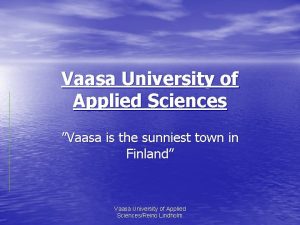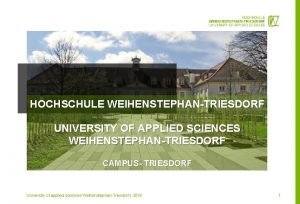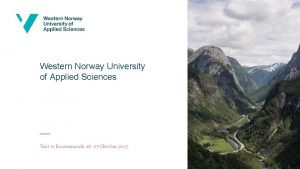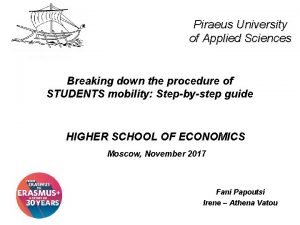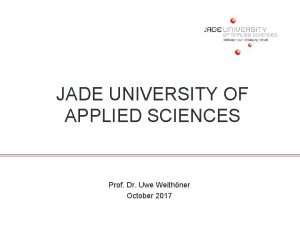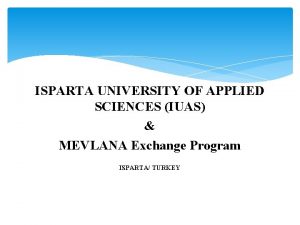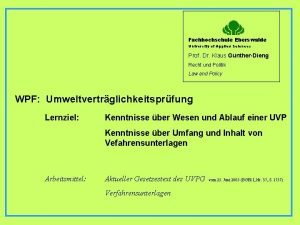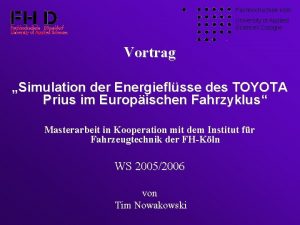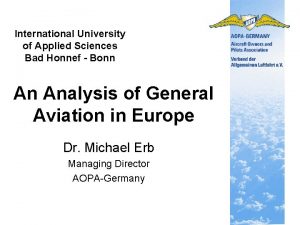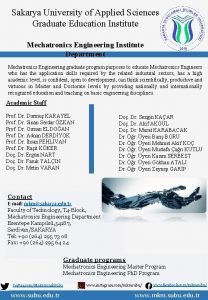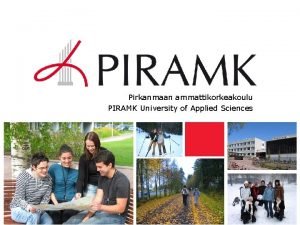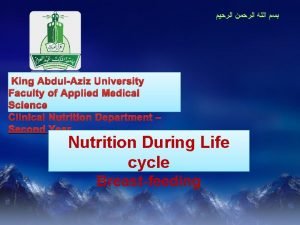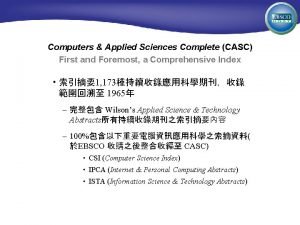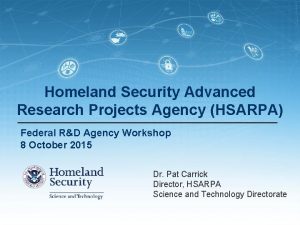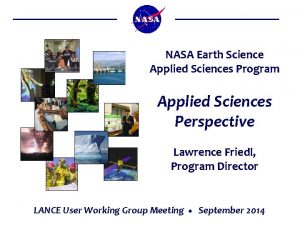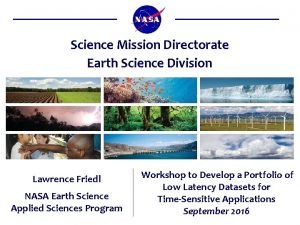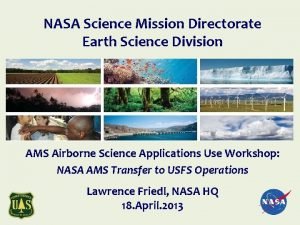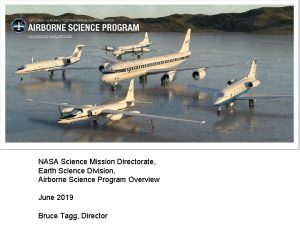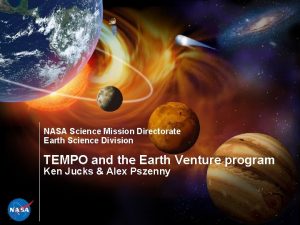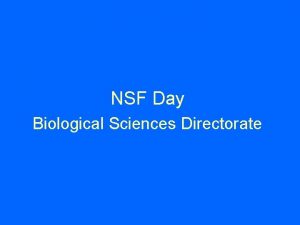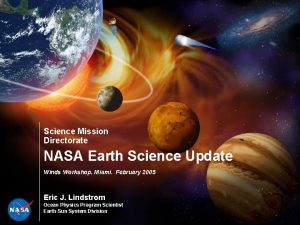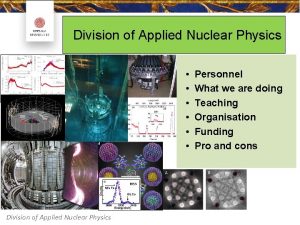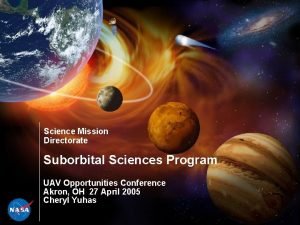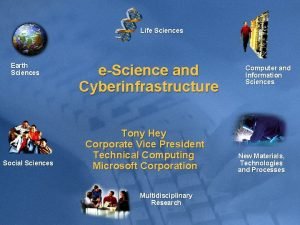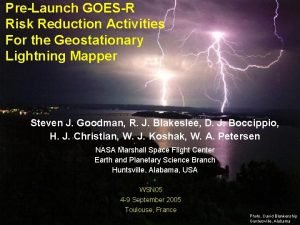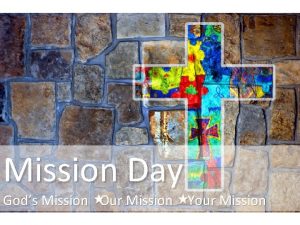Science Mission Directorate Earth Science Division Applied Sciences



















- Slides: 19

Science Mission Directorate Earth Science Division Applied Sciences Program John Haynes ESD Applied Sciences Sept. 2015 NRC Decadal Survey Update

Earth Science & Applications from Space Earth Science “Decadal Survey” First one published in January 2007 Second one due to kick-off in 2015 with publication expected in 2017 Conducted by National Academy of Sciences, National Research Council, Space Studies Board with other Boards supporting Appreciation to Art Charo, NRC DS Study Director, for charts on 2 nd Decadal Survey |2

Earth Science & Applications from Space The national strategy outlined here has as its overarching objective a program of scientific discovery and development of applications that will enhance economic competitiveness, protect life and property, and assist in the stewardship of the planet for this and future generations. … a decadal program of Earth science research and applications in support of society – a vision that includes advances in fundamental understanding of the Earth system and increased application of this understanding to serve the nation and the people of the world. 2007 Earth Science Decadal Survey |3

Earth Science & Applications from Space The national strategy outlined here has as its overarching objective a program of scientific discovery and development of applications that will enhance economic competitiveness, protect life and property, and assist in the stewardship of the planet for this and future generations. 2007 Earth Science Decadal Survey 17 recommended space-based missions for Earth Observations New “Earth Venture” line of low-cost, PI-led investigator missions Increased support for airborne data Additional recommendations on data, information systems, technology development, etc. |4

Decadal Survey: 2007 Organization Committee on Earth Science and Applications from Space Panel On Land-Use Change, Ecosystem Dynamics, And Biodiversity Panel On Weather Science And Applications Panel On Climate Variability And Change Panel On Water Resources And The Global Hydrologic Cycle Panel On Human Health And Security Panel On Solid-Earth Hazards, Natural Resources, And Dynamics Panel On Earth Science Applications And Societal Benefits Note: Organization for 2017 Decadal Survey is TBD

2 nd Earth Science Decadal Survey: Earth Science and Applications From Space (ESAS) 2017 • Sponsors: § NASA-Earth Science Division; § NOAA-NESDIS; and § USGS, Climate & Land Use Change The Statement of Task (SOT) is what drives what the Committee will focus on, address, report, and produce. 6

Primary Elements of the SOT • Assess progress in addressing the major scientific and application challenges outlined in the 2007 Earth Science Decadal Survey. • Develop a prioritized list of top-level science and application objectives to guide space-based Earth observations over a 10 -year period commencing approximately at the start of fiscal year 2018 (October 1, 2017). • Identify gaps and opportunities in the programs of record at NASA, NOAA, and USGS in pursuit of the top-level science and application challenges—including space-based opportunities that provide both sustained and experimental observations. • Recommend approaches to facilitate the development of a robust, resilient, and appropriately balanced U. S. program of Earth observations from space. Consider: Science priorities, implementation costs, new technologies and platforms, interagency partnerships, international partners, and the in situ and other complementary programs carried out at NSF, Do. E, Do. A, Do. D. 7

Agency-Specific Tasks NASA • Recommend NASA research activities to advance Earth system science and applications by means of a set of prioritized strategic “science targets” for the spacebased observation opportunities in the decade 2018 -2027. (A science target in this instance comprises a set of science objectives that could be pursued and significantly advanced by means of a space- based observation. ) …… For each science target, the committee will identify a set of objectives and measurement requirements/capabilities for space-based data acquisitions. If appropriate and usually only for recommendations associated with major investments, the committee will (via a “CATE” process) assemble notional proof-of -concept missions with the recommended capabilities in order to better understand the top-level scientific performance and technical risk options associated with mission development and execution. • Other NASA tasks include: The committee will pay particular attention to prioritizing and recommending balances among the full suite of Earth system science research, technology development, flight mission development and operation, and applications/capacity building development conducted in the Earth Science Division (ESD) of the Science Mission Directorate. 8

Second Earth Science Decadal Survey STATEMENT OF TASK For NASA, the committee will pay particular attention to prioritizing and recommending balances among the full suite of Earth system science research, technology development, flight mission development and operation, and applications/capacity building development conducted in the NASA Earth Science Division (ESD). In particular, the committee will make recommendations on: ESD Portfolio The target budgetary balance between Flight and Non-Flight aspects Flight Portion [Balancing] new measurements against time series extensions of existing data sets (i. e. , relative importance of continuing an existing mission with a follow-on and the initiation of a new mission/measurement) Non-Flight Portion [The] target balance between R&A, Applied Science, and Technology elements; Any changes in scope(s) of the non-flight R&A, Applied Sciences, and Technology Development elements. |9

Second Earth Science Decadal Survey STATEMENT OF TASK The prioritization process will include reconsideration of the scientific priorities associated with the named missions from 2007 Earth Science and Applications from Space Decadal Survey. | 10

Agency-Specific Tasks of Draft SOT NOAA & USGS • The decadal survey committee’s recommendations will be framed around national needs, including, but not limited to research priorities. …. Recommendations may be organized around 1) how new technology may enhance current operations, and 2) what new science is needed to expand current operations, either to enable new capabilities or to include new areas of interest. In making these recommendations, the committee will consider the need to bridge current operations and support a viable path forward for the uninterrupted delivery of public services through these generational changes. • Other tasks include: suggest approaches for evaluating and integrating new capabilities from non traditional suppliers of Earth observations; may offer recommendations concerning “research to operations” (or “innovation for continuity and service improvements across agencies”); and consider the agencies’ ability to replicate existing technologies to improve and sustain operational delivery of public services. 11

Serving on the Survey • A website has been created that will let you nominate yourself or someone else for service on one of the survey committees. We expect ~ 100 members will serve on an approx. 18 -member steering committee or one its approx. 12 -member study panels or working groups. • NASA, NOAA, and USGS employees may serve if they are not in senior management and/or have control over budgets that could be affected by the survey’s recommendations. Committee members are also vetted for potential sources of bias and conflicts of interest. bit. ly/ESASsignup 12

STATUS • NRC Approval, May 6, 2015 • Executed contracts from sponsors: Mid-June. • First task: appointment of survey leadership, to be followed by rest of steering committee. Panel appointments once survey organization finalized. CESAS working on white paper requests to front-end survey • Co-chairs: Waleed Abdalati (U. of CO); Antonio Busalacchi (U. of MD) • • NRC Boards covering atmospheric sciences, polar research, ocean science, hydrology, and the solid Earth will be collaborating partners with the Space Studies Board • Includes membership, execution, staffing, etc. • One-day mini-workshop to discuss survey organization and other toplevel issues with survey leads, community representatives, NRC staff and board representatives: TBD • Final report due ~ 2 years from survey start. 13

Second Earth Science Decadal Survey Notional Schedule (NOT official – estimated by NASA) The organization of the panels for ESAS 2017 will be a decision for the survey steering committee; NRC has budgeted for 6 -7 panels and several cross-disciplinary working groups. | 14

Backdrop: In Addition to Tight Budgets… • NASA: Has a backlog of missions recommended in the inaugural survey and increased responsibility—without commensurate budget increases— starting after the JPSS-1 era for vertical profiles of stratospheric and upper tropospheric ozone, solar irradiance, Earth radiation budget measurements, and altimetry (beyond Jason-3). • NOAA: Stabilizing the weather satellite portfolio and avoiding a potential gap between the NPP spacecraft and the first of the nextgeneration POES systems, JPSS-1, is a top priority. “Climate”-related instruments moving to NASA. • USGS: Interest in survey focuses on future capabilities, including hyperspectral, for a sustained land-imaging program and options for Landsat follow-ons. However, L-9 is projected to be a near -rebuild of L-8 for launch in in 2023. (TIRS on L-8 only has 3 -year design life; NASA looking at Class-D TIR free-flyer for 2019 launch. ) 15

What Happens to Missions Recommended in the Previous Survey? TBD, but: • In developing its recommendations, survey to “include reconsideration of the scientific priorities associated with the named missions from the 2007 decadal survey. ” • The 2007 survey did not prioritize among the 15 missions for NASA; placement in 1 of 3 time periods (Tiers I, III: 2010 -13, 2013 -2016, 2016 -2020) was based on factors including technical readiness; cost; synergy with existing, planned, or recommended missions; and consideration of int’l activities. • ESD has expressed an interest in having the survey provide guidance on technology investments that will be needed to address recommended science targets. • Previous surveys have assumed missions in formulation to be considered part of the baseline program of record. 16

Other Questions • Why is this survey different from all other NRC surveys? • Systems Approach—Advances require study of the Earth as an integrated system • • • Research driven by user needs Science informs policy Inherently multiagency; R 2 O and continuity are perennial issues • How will this survey differ from the inaugural survey? • • No longer appropriate to recommend based on an aspirational budget • Likely that the science will be “valued” to avoid having one recommended activity grow at expense of all others • Increased opportunities to consider “new space” ideas—new players, smaller and less costly platforms, constellations, hosted payloads etc. • Improved consideration of international partners Congressionally-mandated independent cost appraisal and technical evaluation (CATE) for big ticket items 17

Earth Science Decadal Survey Research and Management What key questions and advancements does the Earth science and applications community need to address in the next 10 -15 years? What key questions – if addressed well or answered – would make major advances in our knowledge and its use in decisions and actions? What are key questions and challenges that address both scientific needs and societal decisions? In addition to research questions and reasons for measurements, input from users and managers on needs for advancement and what that impact can mean on the ground can provide language to the Decadal Survey panels to a) help with influence within panel discussions and b) write more cogent, compelling rationales. | 18

NASA ROSES: E. 2 Symposia & Workshops Funding Available – ROSES Element E. 2 NASA ROSES has an open, standing solicitation for proposals to support topical workshops, symposia, and conferences. Rolling submissions for this ROSES element. (ROSES-2015 goes until ~ 3/31/2015 In addition to the event, funds can support time and work to organize and prepare materials leading to the event as well as post-event work to disseminate results and conduct follow-on work. Encourage this community to propose events. Note: Directed at scientific & technical events – not ones focused primarily on education, public outreach, or administrative conferences. http: //nspires. nasaprs. com/external/
 Human sciences
Human sciences Van hall larenstein, university of applied sciences
Van hall larenstein, university of applied sciences Vaasa university of applied sciences
Vaasa university of applied sciences Oulu university of applied sciences
Oulu university of applied sciences Ima hswt
Ima hswt Kju university hungary
Kju university hungary Western norway university of applied sciences
Western norway university of applied sciences Piraeus university of applied sciences
Piraeus university of applied sciences Jade university of applied sciences
Jade university of applied sciences Isparta university of applied sciences
Isparta university of applied sciences Eberswalde university of applied sciences
Eberswalde university of applied sciences Mischhybrid
Mischhybrid International university of applied sciences bad honnef
International university of applied sciences bad honnef Subu mkm
Subu mkm King abdulaziz university faculty of medicine
King abdulaziz university faculty of medicine Pirzmak
Pirzmak Applied medical sciences
Applied medical sciences Computers & applied sciences complete
Computers & applied sciences complete Dhs science and technology directorate org chart
Dhs science and technology directorate org chart Applied science vs pure science
Applied science vs pure science


